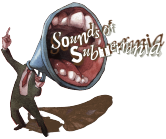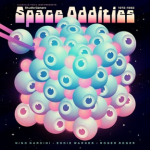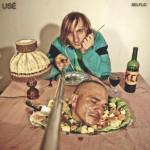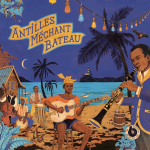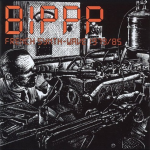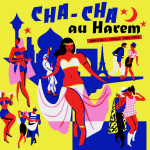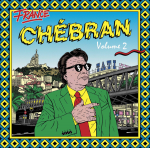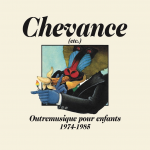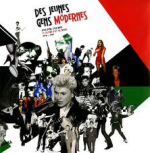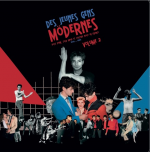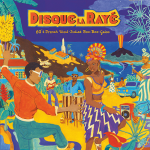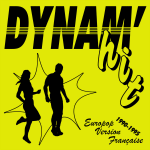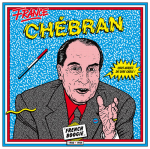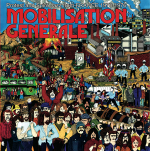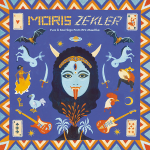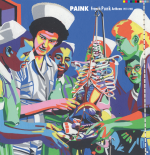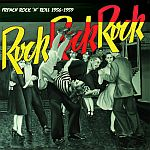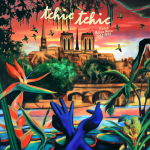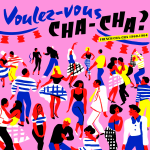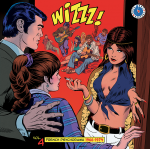Labels
Born Bad
SPACE ODDITIES - STUDIO GANARO
Feat ROGER ROGER, EDDIE WARNER & NINO NARDINI 1972-1982
[engl] During the 60s and 70s, three distinguished old gentlemen who had built their careers playing “made in France” exotic jazz – Roger Roger, Nino Nardini and Eddie Warner – met every evening in the Ganaro recording studio, playing like kids with their new toys: souped-up keyboards that looked more like prototypes of spaceships to explore the Milky Way. Flying high on whimsical and joyful inspiration, the improbable trio used their strange instruments to sketch out the beginnings of something that, at that time, resembled the future of music. Let’s take a trip with them toward a pop, light-hearted and electronic future. At the dawn of the twentieth century, Roger Roger and Georges Achille Teperino entered the world. Roger was born in 1911 in Rouen; Teperino the year after in Paris. They followed in their parents’ footsteps. Roger’s mother was a singer, and his father conducted the orchestra at the Opera. Teperino was taught music by his father, an Italian violinist and composer. Roger and Georges met in secondary school in 1927 and became the very best of friends, to the extent that Roger’s first wife was Teperino’s mother, making the latter his son-in-law. They formed a band called Les Diables Rouges (The Red Devils) that played halls and nightclubs where people would swing dance. For the band, Teperino adopted a nickname that made him famous: Nino Nardini. After World War II, he formed the Nino Nardini orchestra, specializing in “exotic” musical styles. They set the dance floors on fire in the clubs where young people, when not flirting, would twirl to the paso doble, foxtrot, calypso, slow rock, cha-cha and tango. At the same time, he conducted an orchestra for Radio Luxembourg, and one in a traveling circus, providing closely-tailored accompaniment for acrobats, clowns and lion tamers. For his part, Roger Roger (his real name) also worked as a conductor at Radio Luxembourg and accompanied Edith Piaf, Maurice Chevalier, Jean Sablon and Charles Trenet on stage. Radio France asked him to record some of his compositions as production music for its programs. These melodies attracted the attention of Chappell & Co., a music publisher in London that had just opened a department specializing in library music, which they sold “by the ton” to radio, television and cinema. Roger thus made his debut in production music. He was to become an emblematic figure in this domain, for the profusion and eclecticism of his productions, but, above all, his pronounced taste for experimentation. Nardini soon joined him in what appeared to be a new Eldorado. Together the pair made a clean break with rigid French traditions, via compositions featuring unexpected instruments like the harpsichord, marimba and Ondioline. Later, when the first analog synthesizers, oscillators and other electronic keyboards appeared, they were adopted as well. Always seeking innovative sounds, Nardini got deeply into concrete music in the early 60s, as put forward by Pierre Schaeffer (who had just founded the GRM, Groupe de recherches musicales), popularized by Pierre Henry and twisted by the whimsical Jean-Jacques Perrey. Seeking independence, Roger and Nardini decided to create their own studio in Jouy-en-Josas, southwest of Paris. They handled the creative side, while Francis Gastambie took care of the business end. The studio was named “Ganaro,” an acronym of the first two letters of their respective family names. It became the scene of magical nightly sessions of experimentation, in the company of their friend Eddie Warner. The acquisition of a Moog synthesizer brought these pioneers of electronic music to a new level. Roger Roger manufactured his own punch cards to invent new sounds. Then, in 1969, under the pseudonym of Cecil Leuter, he published the albums Pop Electronique and TVMusic 101 (with Nardini), two truly avant-garde “100% electronic” disks that anticipate the hegemony of machines in pop music, from space disco in the late 70s to the electro funk of the early 80s. With a Stakhanovite output of production music, the duo composed more than 40 albums (including the incredible Informatic 2000) for specialized labels: Chappell Music, Southern Library of Recorded Music, Neuilly, IM (Eddie and Hannelore Warner’s label, which published, notably, The Strange World of Bernard Fèvre in 77) Mondiophone, Hachette, Musax and Crea Sound Ltd. A veritable Atlantis of electronic music, rediscovered at the turn of the 21st century by electronic artists like Barry 7 of Add N to (X), with his Connectors series, or Luke Vibert, with the Nuggets compilation. Jess and Alexis Le Tan contributed a bit as well, digging up a few gems from “Ganaro’s Nights,” tracks composed with joy and humility by a merry trio of sixty-somethings for whom making music was always a source of amusement and wonder. Nino Nardini passed on in 1994; Roger Roger in 1995. Eddie Warner (the fortunate composer of the theme song for the TV game show “Des chiffres et des lettres”) had died a few years earlier.- Format
- LP
- Release-Datum
- 19.04.2016
- EAN
- EAN 3521381535976
- Format
- CD
- Release-Datum
- 19.04.2016
- EAN
- EAN 3521383435960
- 01. Peba
02. Rew Be Me
03. Femme Africaine
04. Montealla
05. La Musique
06. Idesouse
07. Iseo
08. TimtituStar Feminine Band
Femme Africaine
Aus einer abgelegenen Region im Nordwesten von Benin kommt die siebenköpfige Star Feminine Band, eine Gruppe junger Mädchen im Alter zwischen neun und fünfzehn Jahren, die frech, unbeschwert und voller Energie Genres wie Garage-Rock, Pop und traditionelle Songs ihrer Heimat durcheinanderwirbeln. Geboren wurde die Band 2016 als Idee des professionellen Musikers André Baleguemon. Er wollte eine ausschließlich weiblich besetzte Band zusammenstellen, die sich den aktuellen Themen der Zeit annahm. Im Zentrum sollten Gitarre, Schlagzeug und Keyboards stehen, weil er diese Instrumente seit seiner Kindheit im ländlichen Tchaourou als Zeichen von Moderne bewundert hatte. Der Grund für seine Initiative: „Im Norden haben Mädchen keine Möglichkeiten weiterzukommen und Frauen werden an den Rand gedrängt. Ich wollte einfach zeigen, wie wichtig Frauen in der Gesellschaft Nord-Benins sind, indem ich ein weibliches Orchester gründe.“ Gesagt, getan: Unterstützt von der 35.000 Einwohner zählenden Stadt Natitingou, die fünfzehn Stunden Fahrt vom Regierungssitz Cotonou entfernt liegt, veröffentlichte André eine Pressemitteilung beim Radiosender Nanto FM, in der er kostenfreie Musikstunden für Mädchen anbot. Dem Aufruf folgten Dutzende junger Musikerinnen. „Die Mädchen wussten nichts über Musik – wir entschieden uns für sieben Mädchen aus den umliegenden Dörfern mit Waama und Nabo-Hintergrund. Einige von ihnen hatten Instrumente wie Keyboards noch nie gesehen.“ André kaufte zwei Schlagzeuge, zwei Gitarren, Keyboards und Percussion und die ersten Proben mit den hochmotivierten neuen Rekrutinnen begannen. Die Band machte in den intensiven Workshops und Proben erstaunlich schnell große Fortschritte und es kristallisierte sich folgendes Line-Up heraus: Angelique und Urrice an Schlagzeug und Gesang, unterstützt von der dritten Schlagzeugerin Marguerite, Sandrine an Keyboards, wie auch Grace, die außerdem singt. Julienne ist am Bass und Anne an der Gitarre zu hören. Die Band hat mittlerweile Dutzende Konzerte in der Region gespielt, ihr Repertoire immer weiter ausgebaut und viele Fans vor Ort gewonnen, darunter viele Frauen, Eltern mit ihren Kindern und Ältere, für die es ansonsten auf dem Land nur wenig kulturelle Ablenkung gibt. Neben den musikalischen Fortschritten legt André Baleguemon einen weiteren Schwerpunkt seiner Arbeit darauf, die Familien von der Wichtigkeit des Projekts auch in menschlicher Hinsicht zu überzeugen, und zu bewirken, dass die Mädchen weiter in die Schule gehen statt in Gelegenheitsjobs als Straßenverkäuferinnen oder in die Heirat gezwungen zu werden. Es gibt in der Geschichte der populären Musik Afrikas viele große Künstlerinnen, aber nur wenige weibliche Bands, darunter die Amazones de Guinée, die Famille Bassavé und les Colombes de la Révolution in Burkina Faso, die Sœurs Comoë aus der Elfenbeinküste oder die Lijadu Sisters aus Nigeria. In Benin gab und gibt es nichts Vergleichbares in puncto Haltung, Freiheit, Originalität und vor allem Talent. Haupteinflussquelle für die Band ist laut André die große Angélique Kidjo, die selbst aus dem Benin stammt: „Sie ist eine Frau, die man nicht ignorieren kann. Auch auf Miriam Makeba wie auch Sagbohan Danialou und Stanislas Tohon sind wir sehr stolz und Kaba Diya, das große Orchester aus der Gegend hat uns stark inspiriert.“ Das zwischen 1979 und 1983 aktive Orchester Kaba Diya hatte sich nach dem Helden der Region „Kaba“ benannt, der im Ersten Weltkrieg den Militärdienst verweigerte und danach einen bitteren Guerillakrieg gegen die französische Kolonialmacht führte. In vielen ländlichen Regionen des afrikanischen Kontinents und auch in manchen Metropolen hat sich das Leben der Frauen seit den 1960er Jahren, als während der Unabhängigkeitskämpfe ein positiver Wandel zu Modernität, Kultur und Emanzipation angestrebt wurde, kaum verändert. Selbst die aktuelle MeToo-Bewegung hat bislang keinen spürbaren Wandel bewirkt. Die Star Feminine Band thematisiert die Lage der Frauen in ihren Texten, die in verschiedenen Sprachen verfasst sind. André Baleguemon dazu: „wir komponieren Songs in Französisch, Waama und Ditamari, zwei unbekannte ethnische Gruppen aus dem Norden. Wir singen in unserem neuen Repertoire auch Songs in Bariba und Fon, der Hauptsprache in Benin, um von möglichst vielen Menschen verstanden zu werden.“ André komponiert die Songs, aber alle sieben Bandmitglieder bringen ihre eigenen Ideen mit ein, wie er sagt: „Sie sprechen über die weibliche Genitalverstümmelung, Missbrauch und Gewalt gegen Frauen. Wir wollen diese Themen in die politische Debatte in Benin und wenn möglich, auch anderswo in Afrika einschließen.“ Der Song „Peba“ ist in der Sprache Waama geschrieben und handelt von Mädchen, die zur Schule gehen, um sie selbst sein zu können; in „Femme Africaine“ geht es auf Französisch gesungen um Selbstbestimmung und Freiheit. „Timtilu“ in der Ditamari-Sprache animiert dazu, die eigene Kultur zu ehren und nicht aufzugeben; „Rew Be Me“ in der Peul-Sprache, ist eine Ode an die Frau, ein Song über die Emanzipation und eine Bestärkung, den eigenen Weg zu gehen. Das in Bariba gesungene Stück „Iseo“ will die Menschen aus unterschiedlichen Regionen und Kulturen vereinen, um sie voranzubringen und „Idesouse“ spornt Mädchen dazu an, ihre Schulzeit nicht zu früh zu beenden. Ende 2018 brachte ein Treffen mit dem jungen französischen Toningenieur Jérémie Verdier das Projekt in Bewegung. Er holte seine spanischen Freunde Juan Toran und Juan Serra mit ihrem Aufnahmegerät an Bord, um die ersten Songs im Anbau eines Museums in Natitingou einzuspielen. Rein zufällig hörte Jean-Baptiste Guillot vom Label Born Bad Records die Aufnahmen und beschloss, die Band Ende 2019 in ihrer Heimat zu treffen. Daraus entwickelte sich die jetzt anstehende Albumveröffentlichung. Mit einer gehörigen Portion Selbstvertrauen, viel Charisma und nicht zuletzt einem tiefen Glauben hat sich die Star Feminine Band zum Stolz der Atakora-Region entwickelt. Die Bandmitglieder verkörpern die Zukunft. Sie schauen sich nach Ausbildungsberufen um und bereiten damit den Boden für die nächste Generation der Mädchen aus der Provinz. Gerry Goffins berühmte Aussage „In the Sixties, God was a young black girl who could sing” nimmt sechzig Jahre später in einer vergessenen Provinz des afrikanischen Kontinents neue Bedeutung an.- Format
- LP
- Release-Datum
- 13.11.2020
- EAN
- EAN 3521381 561852
- Format
- CD
- Release-Datum
- 13.11.2020
- EAN
- EAN 3521383 461846
STEPHAN EICHER
spielt NOISE BOYS
Electro 80's Minimal punk. Denkt an GRAUZONE mit DAF mit SUICIDE. Stephan Eicher spielt Noise Boys' ist der Titel der ersten 7" von Stephan aus dem Jahr 1980 (Off Course Records ). Aufgenommen wurde das ganze in der Bar in der er arbeitete mit einem Diktaphon. Die 7" wird jetzt als LP mit Bonussongs via Born Bad wiederveröffentlicht. 6 Monate später startet er mit dem Überhit" Eisbär" seiner Band Grauzone durch.- Format
- LP
- Release-Datum
- 10.02.2010
- Format
- CD
- Release-Datum
- 10.02.2010
USE
CHIEN D’LA CASSE
[engl] While some are still milking the garage rock for all its cool like it will never dry out, the sleaziest alley cats are gone drinking somewhere else. Sitting on a cinderblock in the darkness of a cave in the suburbs, drinking out of a warm beer, they’d rather witness the convulsions of a degenerating French song. Crafted with some second-hand gear and crumbs of poetry, this lament from the slums has Noir Boy George as its flag bearer, and Jessica93 as companion of misfortune. You will hear it filling the air of tiny and barely sound-proofed venues, to the greatest and perverse delight of all those that the prevailing festivism has made wary, and not quite convinced that we live in the best of times. When you’ve learnt music by fiddling with cheap kids’ instruments from the shopping mall, you end up with a tinkered tune that doesn’t rely on virtuosity, but hijacks anything it gets its hands on, and offers you the result in the shape of a wrecked toy imbued of magic. Nicolas Belvalette, known as Usé, doesn’t really play the guitar, and that is barely a guitar anyway. He hits on it, strikes the same chord ad nauseam, sticks a zinc cymbal on the neck, plays six instruments all at once. With Headwar, that includes three members equally versed in the mysteries of rhythm and multitasking, he atomizes the labels of “noise”, “rock” and “techno” that help us taming noise. He brings us back to the core foundations of sound, those primitive pulsations pre-existing language or melody, when the beating of our heart was all there was to our sound universe, at the bottom of our amniotic condition. For a while Nico managed a concert venue in Amiens, l’Accueil Froid : when the place closed down, he ran in some local election under the label of a fanciful party, le Parti Sans Cible, and got 2,17% of the votes. Right after that, the readers of local newspaper Courrier Picard elected him their personality of the year. L’Accueil Froid reopened, somewhere else. Just another line in a life that already resembles a novel. With a delicate health, subject to the most surreal accidents (during a festival, he got ran over by a car while he was sleeping in his tent), Nico never seemed to have a career plan, and spends half of his life on the road. He juggles with numerous projects (Headwear, Les Morts Vont Bien, Roberto Succo, Yvette Corner But, Sultan Solitude, and many others), he ekes out in this musical interzone that is the great tribe of the DIY, where the release of a cassette or a bandcamp EP are family events. “Usé”, his solo project since 2011, releases today an album on Born Bad, Chien de la casse. On the cover, a dusty van stands in the half-light of an abandoned barn, with a pack of dogs hastily gathered : nothing here is made-up. Yet, the colors are warm, the mood is relaxed. No pity party here. We almost envy the guy at the centre of the picture, who is lucky enough to spend his days indulging in the child-like pleasure of hitting anything the hardest you can, in a pristine environment solely surrounded by animals. Usé’s music is like that free party that we’ve looked for in this pitch-dark night, in the heart of the forest, led by the thumping noise coming from the ground : wild and aggressive, yet welcoming and touching in its bareness. You surrender to the mighty power of the trance, embrace the regressive pleasure of the drums wreaking havoc, the flimsy jingles, the texts rhythmic as a Dada poem. The heck with tomorrow, when the day will rise, because right now everything shivers with a frenzy that feels like life itself, and you won’t find this anywhere else. There are seven tracks on Chien de la casse, duly introduced by the spiteful grunts of a pissed-off mongrel, most likely a Cerberus guarding the trailer of a meth dealer in Indiana. Over the course of six tracks, Usé sounds as though he is writing an ode to break-ins in garbage dumps with the sole purpose of banging on rusty cans until they burst. Only “Sous mes draps” echoes like a sad nursery rhyme, but leaves the realm of social realism to wander on the foggy heights of a fairground horror flick. “C’est si lisse” concludes the album with a fire alarm and some human barking, in an atmosphere of a black mass saturated with backward tapes : the dream ends up in chaos, it’s almost day. Actual violence begins. I’ll see you next week at the squat.- Format
- LP
- Release-Datum
- 19.04.2016
- EAN
- EAN 3521381536409
- Format
- CD
- Release-Datum
- 19.04.2016
- EAN
- EAN 3521383436417
- 01. Dans sa corde
02. Cardiaque
03. Danser un slow avec un flic
04. Elle seule
05. Dans un coin
06. En 3 secondes
07. Insomnie le temps d'une nuitUSE
Selfic
[engl] It’s always kind of the same: the guy gets on stage – provided that there is one – looking like a lanky jackal, with a sweater or two on, and without notice he starts hitting on a jumble of cymbals stacked on tattered guitars, wedged between two ancient synths. After a few minutes, he ends up shirtless and everything disappears, crumbled and pulverized: the show, the music, the people around you, the stage – if there was one – and you find yourself in a hand-to-hand combat: the struggle of Man against the machine, the New Age of Metal, the big final crash. What matters then is not what this guy is doing, but the faith he’s putting in it. And what he puts in it is nothing less than his whole life, messily arranged in a large pile of hypnogenic patterns, primitive words, barking, anti-theft alarms, control losses, infernal nights. Then everyone’s free to pull the string that suits them in this huge panic – punk, indus, soundtrack to a urban crime film of the year 3000: as if being so harsh, fierce, and vital was not enough, Usé’s music also leaves you the choice – an incredible luxury at a time when anything’s spoon-shed to the point of having storytelling and opinions delivered turnkey, 100% validated and ready to consume. In fact, the music of Nicolas Belvalette (the man behind Usé, who can also be seen in Headwar, Les Morts Vont Bien, Sultan Solitude, Roberto Succo and about 125 other simultaneous projects) could have contented itself with live performance, where it seems to be reaching its full potential. In view of such firepower, what more could we expect from a record, other than an inevitable disappointment? Well, in fact it’s just the opposite: his first album Chien d’la casse had proven it, and Selflic definitely confirms it. Martial pianos, mongoloid harpsichords, rural techno, social horror: this new record contains all it takes to writhe, sweat, shudder, pant, stagger, pick yourself up, crawl, howl, faint, get up and pick yourself up again – in short, to have fun. We’ll spare you the truisms about “stepping out of his comfort zone”, about the “darkened atmosphere” or a “chiaroscuro self-portrait”: Selflic is a perfect digest of what Usé was, is, and will probably be for a long time: a terrific machine to crush time and bullshit, to invoke the essential precepts of fire and fury. And that’s all you need to know. The rest is just noise.- Format
- LP
- Release-Datum
- 10.07.2018
- EAN
- EAN 3521381548549
- Format
- CD
- Release-Datum
- 10.07.2018
- EAN
- EAN 3521383448533
- 01. Colosse De Rhodes
02. Sous La Mer C'est Calme
03. Samarcande
04. Sayyara
05. La Ville
06. Le Vide
07. Tamam
08. El Bahr
09. Ultra Moderne Solitude 2
10. Yaaa Yaaa YaaaV/A
ANTILLES MECHANT BATEAU - Deep biguines & Gwo ka from 60’s french West-indies
[engl] The West Indies – a sweet coastline subject to many clichés from another time. That postcard with coconut trees, a glass of rum to sip on, those so exotic madras dresses... Almost as many as in Compagnie Créole’s "doudouist" songs, that say a lot about the misunderstandings from both sides of the ocean. West Indians are still as stuck with this distorted outlook as in the good old days of the colonies. Because, underneath the veneer of moldy images, a completely different reality is woven. ‘They beat drums but were never number one’ – to misquote the chorus by a Martinique-born French singer. This is the subject of this collection – musicians drumming on percussion as a way of asserting their creolized identity. Songs that tell, in veiled terms, a different reality from what mainlanders were fed with. Special cases, with cries of joy and laments accompanied by cadences, as an invitation to trance, all immersed in the Caribbean melting pot of rhythm. “’Antilles’ Méchant Bateau”, a low-tempo number with a bolero feel, indeed a pure case of the blues, and a terrific saxophone solo. What else would you expect to set the tone for this selection, in which beguine regains its original colors, in the darkness of the gwo ka drums. This 45 by André Mahy, released under the Aux Ondes sublabel, was recorded in the 1960s at Célini’s, one of Guadeloupe’s two main houses. Through its drum rolls and harrowing chant, it recalled how, long before the mid-1960s, the Antilles’ history was written in an ocean of teardrops – namely the Black Atlantic, as so rightly put by Martinician philosopher and poet Edouard Glissant in L’Archipel des Grands Chaos. These “cursed boats” – slavers – carried millions of Africans to the American continent for centuries. All this sinister story had begun with the landing of a fleet of caravels steered by Christopher Columbus in 1492. It was the first step towards a colonization that was about to decimate the indigenous peoples of this terra incognita and deport the vital spark from the cradle continent of humankind. A year later, on November 4th, 1493, the same Colombus christened Guadeloupe after the Royal Monastery of Santa María de Guadalupe in Extremadura. The cross – a booming symbol – was there to justify the ordeal of peoples to whom even humanness was denied. Soon, once the Caribbean tribes were eradicated, the French would massively import workforce from Ghana, Togo, Dahomey, Ivory Coast, Nigeria, Cameroon, Gabon, Congo or Angola, as recalled by the Marches dedicated to the various ethnicities of slaves in 2012, which faced the Memorial of the ka drum on the Grande-Terre island in Guadeloupe. Hundreds of thousands of them would have to survive the nightmare of plantations, comparable to the plantation system in the American South: chains, leg irons, shackles, fetters, garottes, iron collars and branks, dungeons or lynchings set the tempo of everyday life. The sugar aristocracy (the brown gold of the time) set a reign of terror on plantations. The masters had full powers, including life and death, over the slaves who worked from four in the morning to sunset… until April 27th, 1848 – date of the second and definitive abolition of slavery thanks to the struggle of Victor Schœlcher, an MP who was close to Lamartine (the first one had been pronounced in the wake of the French Revolution, but soon repressed in blood by Bonaparte...). However, the path would still be long to see the newly-born Republic’s motto applied: Liberty, Equality, Fraternity ... The "post-slavery" society would perpetuate real economic segregation – a distinction that would be reproduced from generation to generation... And even if, a century later, the law of 19th March 1946 granted the four old colonies the status of Overseas Departments, nothing changed in the course of history. This gap would then widen, differently but surely, as the Republic implemented an assimilation policy that would deny identities and make a clean break with the past. In this fool’s game, the ka became, in the 1960s, the voice of identity for Guadeloupeans who couldn’t resolve being purely and solely disintegrated. Made from salting or wine barrels from the colonial era – boats keep coming back in this ebb and flow movement – the "quarter", or "ka" once creolized, was a powerful symbol of resistance since the colonial era. Even if its practice was quickly proscribed by masters, considering it contained the seeds of revolt, this great drum (long known as a ‘bamboula’, which means ‘pagan festival’ in Haiti, and became a popular expression in De Gaulle's France) inexorably wormed its way into the local culture, until becoming the essential melting pot for the movement of ‘root music’ against mainland France’s deaf hear. Or its beating heart, following the seven specific rhythms of gwo ka. More than just a matter of rhythms, this drum carried a speech full of history and stories, a message of memories and hopes. The gwo ka bore the stigmata of a slave society, from which all its associated chants were inherited. A medium of the voiceless, this drum would act like an ointment on mistreated bodies, but also as a stimulant for rebellious souls. Under the drummer’s fingers, the ka drummed up the ancestors’ spirits. Just like words convey the memory of a people that was long demoted to the status of a simple item of personal property – according to article 44 of the 1685 Code Noir draught by Colbert to regulate the status of slaves – before being governed by a system of identification booklets allowing to monitor the movements and work of the workforce in a Guadeloupe admittedly liberated from slavery, but still looking like a "banana" regime. This trauma appears through a repertoire that reflects the pain of cane cutters and the euphoria of pay day, the oppression of racism and the recourse to the myth of a promised land. Songs burst with all the bestiary that populates the countryside and the many fish that feed stews, acid satires on the daily reality and apposite witticisms on international events, chronicles anchored in the local soil as well as biting plays on words. One may sing to keep vigil over a dead person, or launch into long, saucy tirades at a bibulous party. At the turn of the 1960s, while some bars were still for whites only, while speaking Creole was forbidden in schoolyards, while drum music was considered a "mizik vié neg" (“old negro music”), while the church saw a symbol of degeneration in it, the Maroon spirit – from the name of the slaves who fled plantations to live free in the woods – rose from its depths, in another form. In this decade and the one that followed, this movement, that gave its place back to percussion, accompanied more precise claims as English-speaking islands gained independence. By playing the ka (which was banned from official studios), one actually chose their side. From 1963, the freshly-instituted Bumidom (Office for Overseas Migration) organized a strong West-Indian emigration towards low-skilled jobs and a dull suburban life. In response, the Gong (group for Guadeloupe’s National Organization) called for Guadeloupe’s independence, and two years later, the Guadeloupean Front for Autonomy appeared. Those years were punctuated by strikes and repressions, culminating in May 1967 with a real massacre in the public square in Pointe-à-Pitre, the toll of which would not be disclosed until 2012. Many would denounce the bloodbath operated by the Bumidom among Guadeloupe’s lifeblood. Slogans flourished on walls, including the iconic: Jeune, ne quitte pas ton pays ("Young people, do not leave your country”). Part of the youth got the message, choosing to take the drum back in hand as a symbol of the emasculated identity of this "entirely apart" people, to quote Aimé Césaire, the father of Negritude. The ka became the soundtrack of this generation, who sped up the tempo with the 70s and definitely transplanted it to town, while the plantation economy – the original soil of the ka drum – was in crisis. From then on, the old tambouyés (drummers) finally went celebrated as they should be: Anzala, Carnot, Serge Dolor, Ti Seles, Robert Loyson, Arthème Boisban, Esnard Boisdur ... and especially Velo – born Marcel Lollia – who nevertheless died in misery, in the street, in 1984. “Champs de canne, champs de coton !” ("Cane fields, cotton fields!) Guy Konket roared, one of the great champions of the Guadeloupean cause, whose path followed on from this legacy, moving it onto the asphalt of Carénages, Pointe-à-Pitre’s hot district. The poet sure had a good turn of phrase, that hit the spot just like his mouth drum. No doubt, blues and ka fought the same battle – centuries of oppression, of negation, before finding the path to possible redemption. Between them, the same language – the language of the Creole spirits, flooded in the great ocean. This is what this selection is about, and its good, inborn sense of humor shouldn't hide the implicit commentaries. There, jazz instills an emancipating energy from established formats, giving these songs a musicality that rhymes with spirituality. From infernal cadences borrowing from the "latin" rhythms of neighboring islands, to beguines with percussion-spiced tempos, to more laid-back – nonetheless dark – ballads, this compilation takes us back to the early hours of a movement of rebirth synonymous with recognition. A rejuvenation in which all the musics from the Black Atlantic diaspora naturally intertwine. Like a wave of sounds, of sense and blood, reminding us that an original culture emerged from the holds of these ‘wicked boats’, the trace of which remains starkly persistent in 2018.- Format
- LP
- Release-Datum
- 18.09.2018
- EAN
- EAN 3521381548716
- Format
- CD
- Release-Datum
- 18.09.2018
- EAN
- EAN 3521383448700
- 01. Piero - Quelle époque épique et punk
02. Soda Fraise - Ca baigne dans l'huile
03. Stéfan - J'suis pas méchant
04. Geiger - Je suis punky
05. Too Much - Silex Pistols
06. Gérard Bôle du Chaumont - C'est la défonce
07. Sublime de Luxe - Chose molle
08. Bulldozer - J'suis punk
09. Sublime de Luxe - Donne-moi ton corps, juste pour le sport
10. Les Marylènes - Le beau tétard sur son cigare
11. Gisor - Le plan
12. Anatole Frantz - Le monde est fou
13. Fatsy Wataire - Chimène Hovelicot
14. Gérard Depardieu - La p'tite Agathe
15. Plastichke - Ca gaze pour moi
V/A
BINGO - French Punk Exploitation 1978-1981
[engl] The real, great rock 'n' roll swindle? Don't look for it in the Pistols, well, in Mac Laren' movie The Great Rock 'n' Roll Swindle... you'd better search Belgium, and more specifically somewhere near Lou Deprijck and Yvan Lacomblez, two born-and-bred “Brusselians[1] ”. If their names don't ring a bell at first glance, you've most likely already wiggled to the interplanetary hit which brought them fortune (in every way): “Ça plane pour moi”! Oh yeah, France already had Antoine's “Élucubrations”, a mildly transgressive hit in its own way... and an unprecedented landslide in Gallic memory. But this time, another category was tackled! “Ca plane pour moi”? A moronic song by a crappy singer... The prank swept through the world and within a few months, no less than one million 45s were sold just in France. And the incredible part is that it was to spawn a mass-produced bunch of cover versions, finally becoming – how ironic – a universal punk anthem: think what you will, it IS the hold-up of the century! Of course, such a cash cow would arouse envy and create quite a few vocations among our fellow countrymen. The song's trademark derision was finally about to bridge the missing link between original punk – too violent, too dirty – and the general public eager to enjoy a little Saturday-night pogo. Once more, humor became the magic bullet to conquer a frightened audience: even though the French aren't exactly fond of rock'n'roll, they've always loved a good laugh. The formula had already proved successful. Remember the arrival of rock'n'roll in France (1957) through Boris Vian, Henri Salvador and Michel Legrand. Their famous, jokey “Rock and Roll-Mops” already laid the foundations for the same equation (refer to Born Bad's Rock Rock Rock comp for a deeper look): joke + rock'n'roll + derision = success. The big labels sure did try to produce punk bands in France – Polydor, the most daring one, signed up the Stinky Toys and the Guilty Razors in a row – but only to result in huge commercial failures which ended up discouraging the entire profession. But in the face of Mr. Bertrand's huge success, those big labels thought they got how it works. Very soon, music publishers and majors all wanted a punk hit. From Barclay to RCA to Polydor, all discovered a passion for punk and wanted their own “Ça plane pour moi”. So A&R executives from big labels and publishers brought all of their seasoned producers, composers and lyricists into the stampede: eccentric arrangements, daft and stereotyped lyrics – one-upmanship was the rule. Anything served as a pretext to be punker than punk – who cares if grotesqueness and ridiculousness were constantly flirted with, what we want is good laugh (and a shitload of cash!). An unprecedented bunch of punk-novelty records followed. Even André Verchuren had his own unbridled accordion cover version of “Ça plane pour moi” – that's saying something! Sure, most of these punk hoaxes are real lousy, real shitty but one must admit that some numbers stand out of the crowd. While they didn't reach the success of “Ça plane pour moi”, some, here and there, were really inspired and – let's be punk – even more creative than the songs they hijacked and mimicked. So, as would say Pierô who opens the comp: “Hey guys, got your guitars out of tune? let's play PUNK today! and start up the infernal machine. Ein, Zwei, Drei quattro...”- Format
- LP
- Release-Datum
- 25.05.2017
- EAN
- EAN 3521381537949
- Format
- CD
- Release-Datum
- 25.05.2017
- EAN
- EAN 3521383437933
- 01. Trois Dans Les WC* - Contagion
02. Act - Ping Pong
03. Les Visiteurs Du Soir - Je T'écris D'un Pays
04. Vox Dei Terroriste
05. Comix - Touche Pas Mon Sexe
06. TGV - Partie 1
07. C.K.C - 20h25
08. Marie Möör - Pretty Day
09. Deux - Game And Performance
10. Ruth - Polaroid Roman Photo
11. Vitor Hublot - Aller Simple
12. Visible - Le Jour Se Lève
13. Casino Music - Viol AF 015V/A
BIPPP - french synth wave 1979/85
Mit dem BIPPP Sampler bringt uns das in Frankreich ansässige Label Born Bad ein Stück französischer 80s Untergrundmusikgeschichte für das manche Leute töten würden wenn sie die Originalaufnahmen in die Hände bekommen würden! Die Compilation ist vollgestopft mit extrem raren französischen Minimal-, Synth- & Coldwave. Der Großteil der Songs sind dabei wohl auch nur dem engeren Kreis der Minimalsammler bekannt, können hier aber dankenswerter Weise auch endlich einem (etwas) größerem Publikum präsentiert werden. Wer frühe Soft Cell, Silicon Teens, Grauzone, Nouvelle Vague die von Martin Hannett produzierten belgischen Names oder ähnliches mag kommt hier wirklich nicht dran vorbei. Großer Tip für alle die auf schrägen 80s Epop, Postpunk und Minimalelektronik stehen, inkl. tollen beiheft- leider nur auf französisch!- Format
- LP
- Release-Datum
- 07.08.2007
- Format
- CD
- Release-Datum
- 06.01.2010
- 01. Léo Clarens et ses Rythmes Orientaux - Cha Cha Cha au Harem
02. Zina Nahid - Danse du Sud
03. Fred Adison et son orchestre - Inch’ Allah
04. Benny Benett - Couscous
05. Kemal Rachid et ses Ottomans - Loukoum
06. Benny Benett - Ismaïla
07. Kemal Rachid et ses Ottomans- Bagdad
08. Staiffi et ses Mustafa’s - Danse l’amour
09. Los Cangaceiros - El Mechoui
10. Kemal Rachid et ses Ottomans - Au café turc
11. Los Matecoco - Baklava, loukoum, kadaiff
12. Léo Clarens et ses Rythmes Orientaux - Shish Kebab
13. Raymond Lefèvre - Lawrence d’Arabie
14. Trio Joroca - On m’appelle l’oriental
15. Mohammed Ben Abdel Kader - Arabian Night
16. Roger Morris et son orchestre - Oriental Express
17. Ali Baba et son Ensemble - Mahomet de TunisV/A
CHA CHA AU HAREM - Orientica - France 1960/1964
[engl] In 1963, David Lean’s Lawrence of Arabia won seven Oscars. Launching its actors to stardom, including Peter O’Toole and Omar Sharif who played Prince Ali Ibn Kharish at the age of thirty. The latter incarnated the West’s vision of ??the Middle East which was simultaneously elusive, refined and elegant. His fiery stare, impeccable mustache and immaculate haircut had something to do with it: the Egyptian actor was a sex symbol of an era passionate for James Bond and OSS117 spy adventures. In the Jordinian desert, he fascinated an audience that was in search of an escape and the thousand and one nights. This appetite for a colorful and fantasized exoticism, was also prominent in France’s music of the sixties. The country that welcomed Omar Sharif’s first feature films outside of Egypt (Goha, La Châtelaine du Liban) produced a delirious amount of music of Latin or Middle Eastern inspiration, grouped behind the genre named “typical” . This “typical” production is enough to scare away the most motivated and adventurous of listeners: overabundant and often blurry versions, anonymous performers (often accompanied by the same arrangers) and only a few noteworthy songs. Venturing into the moving waters of orchestral music undoubtedly causes disappointment, but here and there, springing up in the middle of a vast ocean, one can find a few cha-cha-cha pearls played in a Cuban or Middle Eastern style. The French equivalent of Exotica records (Les Baxter, Yma Sumac, Martin Denny etc.) for North Americans who were fantasizing about Hawaiian Tikis and the Pacific Islands, the oriental cha-cha-cha fueled dreams of the Middle East and Northern Africa. To rum-based cocktails sipped in a Polynesian setting, the French were to prefer couscous and mint tea. Carrying them across the Mediterranean to nearby Maghreb and even further on to the more mysterious Anatolia. Orientica in short. The context is somewhat paradoxical: decolonization, especially of the Maghreb was not an exactly smooth process. After Morocco and Tunisia in 1956, Algeria acquired its independence in 1962, leaving a gaping wound, still partly open, on both sides of the Mediterranean. Pied-noirs returning to the regions of Paris and Provence with a mixed culture (dishes, humor, etc.). The Cuban missile crisis took place that same year, a paroxysmal moment in the Cold War. Europe was split between two camps. “When will the Russians throw nuclear warheads at us”? But there was also reason to rejoice and be optimistic: the economic growth and baby boom. Reconstruction was in full swing. French families were dreaming of tourism and airplanes. A method of transportation that was still reserved for the elite was developing rapidly. The French sky had been opened to competition. Caravels, the first mass produced civilian twin-jet planes had entered the airspace. The French were discovering Italy, Spain by car and starting to dream of far more distant regions. Records thus offered the average person an easy escape with an extra few puns in there and a little ole-ole, making the product all the more attractive. On Saturdays, young adults took part in ballroom dance parties (dancing the cha-cha-cha, bolero, foxtrot, tango), although physical distances were chaste the spirits were more mischievous than they appeared. Sundays were then spent at the airport, listening to the Boeings chanter là-haut (Boeings singing in sky). The Loukoum – Cha Cha au Harem compilation offers a tender vision of pre-sexual revolution Gaullian France. Including all the stereotypes on exotic countries; culinary specialties (couscous, Turkish coffee, baklava, etc.), sensual oriental dances, exaggerated accents, bewitching chants performed on minor Hungarian scales by European instruments accompanied by percussion of an unknown origin. Aside from being a simple postcard, this music embodied a form of innocence and naiveté, both touching elements to access in these cynical and judgmental times. Catchy and tastefully arranged, the genre’s best tunes contain a delightfully old-fashioned charm. Bob Azzam, an Egyptian singer of Lebanese origin, made it popular in 1960 with Mustapha and Fais-moi du Couscous, Chérie (Make me Couscous, Darling). The musician who started his career in Italy in the late fifties really came to fame in France thanks to these two songs. About twenty LPs were to follow, not all as successful, maybe due to his sometime lack of mastery in terms of quality and productivity. Léo Clarens the French-born Caliph of Francophone oriental Cha-Cha-Cha is omnipresent in this compilation, under his various stage names. Born Louis Tiramani Coulpier in Marseille in 1923, the clarinetist formed his first orchestra at the start of the Second World War. Stranded during part of the war in Algiers, he ended up being promoted to conductor of the 2nd Armored Division! When Paris was liberated, he went to the capital looking for work. There, he recorded his first records (covers of American standards) for the Philips label in the 1950s thanks to the famous Jacques Canetti, one of the greatest French artistic directors of the 20th century. Apart from his recordings under various pseudonyms (Kemal Rachid, the Kili-Cats), the Marseille musician became a popular arranger, in particular for Michel Sardou. He also assisted Paul Mauriat for many years. Later on working with Laurent Voulzy and Jean Jacques Goldman in the seventies and eighties. Léo Clarens was not the only one to give in to oriental cha-cha-cha. A number of musicians threw themselves to the task, most often with mediocre results, but with a few nice surprises such as Benny Bennet or Los Cangaceiros. Benny Bennett is an American musician of Venezuelan origin who lives in France. He recorded many albums and 45 rpms mainly for Vogue in the late fifties and early sixties. A jazz drummer, he discovered Cuban music through his first wife Cathalina. From then on, he recorded mambos, calypsos, boleros and cha-cha-cha including their oriental variations with the excellent Couscous and Ismaëlia. Los Cangaceiros were a Paris based band led by Yvan Morice. They released four albums in the early sixties some of which were also published in the United States, as well as a dozen 45 rpms. Under his real name, Yvan Heldman became a prolific lyricist for films such as Le Vicomte Règle Ses Comptes (1967). We can thank him for the classic Dick Rivers Le Vicomte song. The omnipresence of percussion and drums on Oriental Express gives us some indication of Roger Morris’ favorite instrument: the drums. However, literature and the internet are stingy with details on his career. At most, one can find out that the musician published half a dozen EPs, mainly for the Homère label, as well as two albums, one typical of the early sixties (Surprise Party 2) and a second, Library at L’Illustration Musicale. Raymond Lefèvre’s career was much better documented! Present on this compilation thanks to his reinterpretation of the Lawrence of Arabia theme written by the great Maurice Jarre (father of Jean Michel) in a Bolero style,he was a soundtrack regular. Composing over 700 arrangements, he was especially well known for his participation in Dalida’s Bambino and for the Gendarme of St Tropez soundtrack. On that note, it’s time to sit back and relax in your lawn chair, smoke a hookah (to keep the clichés going) and discover Loukoum – Cha Cha au Harem!- Format
- LP
- Release-Datum
- 21.08.2020
- EAN
- EAN 3521381562149
- Format
- CD
- Release-Datum
- 21.08.2020
- EAN
- EAN 3521383462133
- 01. Phil Barney - Funky Rap
02. JM Black - Lipstick
03. Ettika - Ettika (Version Maxi Inédite)
04. Sammy Massamba - Propriété Privée
05. Shams Dinn - Hedi Bled Nous
06. Alfio Scandurra - Qu'est Ce Qui Ne Va Pas ?
07. Philippe Chany - Cairo Connection
08. Noureddine Staïfi - Dansez Le Raksi
09. Brigitte & Michot - Ta Face Préface
10. Alec Mansion - Trop Triste
11. Marie José Fa - C'Est Tabou
12. Hamidou - Jawla Feli
13. Ganawa - Yamna
14. Créole Star - Break Magic Dane
15. Manu - La Rage Du Funky (Remix)
16. Ethnie - De Chagrin En Chagrin
17. Joel Ferrati - Pourqoui Tant De Haine?V/A
CHEBRAN VOL2 FRENCH BOOGIE – 82/89
Zweiter Teil der Hammercompilation aus dem Hause Born Bad voll mit französischen Disco Boogie.- Format
- DoLP
- Release-Datum
- 07.06.2018
- EAN
- EAN 3521381547207
- Format
- CD
- Release-Datum
- 07.06.2018
- EAN
- EAN 3521383447192
- 01. Anne et Gilles - Conversation
02. Christine Combe - Transformations
03. Jean-François Gaël - Prefiteroles
04. Steve Waring - Image
05. Anne et Gilles - Le Gnou
06. Christine Combe - Conseils aux enfants sages
07. Jean-François Gaël - Sucre Candi
08. Le Groupe Organon - Adieu
09. Alain Savouret - La dictée
10. Anne - Vendredi, les caramels au chocolat
11. Anne - Lundi, les croûtes aux groseilles
12. Le Groupe Organon - Vivre
13. Anne et Gilles - Le soleil
14. Steve Waring - Me uno Me douno
15. Naomi Moudi - Who dat
16. Anne et Gilles - Les Hiboux
17. Steve Waring - Fais voir le son
18. Anne et Gilles - Le môme néant
19. Anne et Gilles - Cela est certainV/A
CHEVANCE - OUTREMUSIQUE pour ENFANTS ( 1975-1984)
[engl] France at the crossroads of the 70s: the Chevance collection revolutionizes music for children. Mixing forward-thinking folk and avant-garde jazz, driven by a strong literary spirit, its exceptional catalog was created under the direction of producer Philippe Gavardin, in the tradition of the Saravah label or iconoclastic publisher Harlin Quist. Anti-fables, songs from mysterious countries, wild bestiaries... It brought together a band of classically inspired free musicians, propelling its singers into orbit by exploiting all the fantastical potential of texts by Jean Tardieu, Robert Desnos, Jacqueline Held and many others. More strictly instrumental, its younger sibling, the Sonoriage collection completed the company, dedicating itself to the acousmatic exploration of children's familiar environments. In the land of Presidents Giscard and Mitterand, thermal clothing and elbow pads, Sautet films and Sunday roasts, the carpeting of a nursery is strewn with a handful of 7-inches. There, exotic birds and courteous elephants guarding a castle built with cakes form a Front for the Liberation of the Imaginary: colourful, systematically framed illustrations standing out against the cream background of gatefold sleeves… doorways to a maze of sounds at the crossroads between the neatest form of chanson and the most prospective jazz. Founded in the course of the 1970s by Philippe Gavardin, the small collection named Chevance is above all the story of buddies who were out and about between the twilight of the Trente Glorieuses and the disenchantment that followed the socialists’ rise to power, gravitating around this mentor known for his kindness and curiosity. Originally a linguist, Gavardin was one of these open-minded intellectuals, with one foot in the Contrescarpe cabarets and the other in step with the avant-garde, combining his apparently classical tastes with a keen interest in the novelties of his time. It is notably with Jean-Louis Méchali—a drummer from the free jazz scene who became Gavardin’s team-mate and arranged a good deal of the releases—that he forged the identity of this series of recordings for the younger generations: musically janus-faced, definitely literary, impregnated with a surrealism that echoed the decade’s psychedelic and libertarian experiments. The label developed a real editorial policy disregarding commercial constraints. Each record took a clear direction: modern fables, bestiaries, musical tales, cookbooks… Words were the backbone and every release was both carefully designed and perfectly manufactured. Several teams were built up in the course of meetings which were more like congenial brainstormings. In the chanson category, Anne and Gilles, a duet regularly performing in the left bank area, alternated with the Swiss actress Cristine Combe who had recently settled in Paris and wanted to sing Kurt Weill. As for the folk projects, Imbert and Moreau, who were more in the hippie vein, took turns with the canonical pioneer Steve Waring, whose famous Grenouilles were then turning round and round in José Arthur’s Pop Club. The musicians included many a jazzman from some of the most adventurous factions of the French scene: Méchali’s fellow travellers involved in the Cohelmec Ensemble; The Marvelous Band, a gang from Lyon that had also co-founded the “Association à la Recherche d’un Folklore Imaginaire” (Association in Search of an Imaginary Folklore); and various mavericks like multi-instrumentalist Teddy Lasry, or the intriguing, so often credited Jacques Cassard, whose track seems to have been completely lost today. Initially distributed by the label Le Chant du Monde, Chevance was definitely included in the catalogue of this venerable parent company when Gavardin started directing it. Thus, it joined a selection of traditional music and work songs also including chanson, poetry and recordings that just can’t be categorised. While bookshops for kids knew a historic boom in France, the collection eventually enjoyed the monopoly of the prizes awarded by “Loisirs Jeunes” or the Charles Cros Academy, a key factor to reach school and library networks. If the collection gives a striking change from mass-produced music for kids, its spirit is nevertheless akin to other singular attempts that were made at the time. Mixing songwriting and avant-garde jazz, Chevance seems to be, first of all, Saravah’s younger sibling. Founded by Pierre Barouh, Saravah showed the same balance between moderation and radicalism, with oddities like those of Brigitte Fontaine, Alfred Panou, Barney Willen and so many other musicians feeding the creative frenzy that characterised the French jazz scene.1 As the Cohelmec Ensemble bridged the two worlds, the teams got to know one another and often worked in the same studios. As for the literary dimension, it is right in the lineage of the American iconoclastic publisher Harlin Quist, whose activity in France left its mark on the genre. Similar selections, a common taste for playful uses of language, and the same distancing from both conventional and outcome-based education… A universe excluding the mundane to make room for cosmogonic visions in which, at the turn of each page, everyday life is relentlessly assaulted by the incongruous. The parallelism with Chevance goes even beyond questions of editorial, graphical or typographical choices: the two worked with the same team of illustrators, which included Henri Galeron, Nicole Claveloux and Patrick Couratin. While Chevance had strong literary roots, Le Chant du Monde developed, in the middle of the 1980s, another collection in a more abstract, rigorously instrumental line, far from textual concerns. Initiated by Anne H. Bustarret, a critic, a major activist in the field of creation for kids and a friend of Gavardin’s, Sonoriage openly campaigned for ”an active initiation to the listening and reading of today’s music based on the attention to every day sonic environments.” Inspired by the many situations she experienced in workshops and the hundreds of hours she spent stirring the imagination of children with a bunch of keys hanging at the end of a string, Bustarret carefully presented each record, systematically adding an illustrated, notebook-like insert to guide the kids’ listening. Bernard Baschet—the sound sculptor who invented, along with his brother François, the “crystal” bearing their name, and worked with Pierre Schaeffer on the typology of sound objects for the Treatise on Musical Objects—was an old friend of Anne Bustarret’s. She therefore naturally turned to him for the Musiques de table project, before he oriented her towards Jean-François Gaël. A cornerstone of the amazingly hybrid band Sonorhc, a student of acousmatics and a first-class arranger who had worked for many of the decade’s singers, Gaël was a crystal lover who followed Baschet around his interventions, including in schools. When Gaël set to work, Bustarret called the composer Alain Savouret, asking him to select excerpts from his tape-recorded Sonate Baroque, so as to compile another volume entitled Musiques en Bande. Renaud Gagneux, who was in charge of the Louvre’s carillon, had just been ringing his bells for Musiques sur la place when she contacted the outsider naturalist Knud Viktor about a project which, unfortunately, was never carried out. As a rather up-to-date though not-so-commercially-successful collection, Sonoriage constitutes a kind of ideal illustration of François Delalande’s theories.2 This very serious member of the GRM also worked as a research supervisor at the National Audiovisual Institute. His theories emphasised the unexpected parallelism between the methods of the most respectable practitioners of concrete music and the way the youngest children explore their sonic environment. Necessarily incomplete and subjective, this very partial overview deliberately draws attention to the most peculiar tracks. Unfortunately, some equally valuable works could not be included: Jean-Louis Méchali and François Ruy-Vidal’s Petit Poucet (a monolithic musical tale that cannot be sized down), Colette Magny’s rough and raucous lullabies, B-sides from the Antifables series, La Promenade de Picasso, a record that had to be destroyed and therefore seems definitely lost… May the most curious listeners feel like putting these fragments back in their broader context so as to (re)discover the vast inheritance this uncommon project bequeathed us.- Format
- LP
- Release-Datum
- 12.04.2019
- EAN
- EAN 3521381551105
- Format
- CD
- Release-Datum
- 12.04.2019
- EAN
- EAN 3521383451090
- 01. Tokow Boys - Elle Hôtesse
02. Guerre Froide – Ersatz
03.Lizzy Mercier Descloux - Torso Corso
04. Ruth – Mots
05. Henriette Coulouvrat – Can't You Take A Joke
06. Kas Product – Man Of Time
07. Ice – La Grande Guerre
08. Mathematiques Modernes – Manekine
09. Metal Boys - Tokio Airport
10. Visible – Essor Assuré
11. Mecanique Rythmique – Extase
12. Charles De Goal – ExpositionV/A
Des Jeunes Gens Modernes 1 - post punk, cold wave et culture Nôvö en France 1978-1983
Klasse Compilation mit altem Wave, Postpunk aus Frankreich. Jetzt endlich nachgepresst.- Format
- LP
- Release-Datum
- 29.02.2012
- EAN
- EAN 5413356348415
- 01. ADN CKRYSTALL - Mini Romance
02. X RAY POP - La machine à rêver
03. ELI & JACNO - Les Tarots ( Ost Les nuits de la Pleine Lune)
04. LES FILS DE JOIE - Les plaisirs chers
05. LES STAGIAIRES - Airport
06. MEDIKAO - WC Boy
07. LA BANDE AU COL ROULE - 60 Amor
08. RADIO ROMANCE - Etrange affinité
09. A.R.T - Foolish Virgin
10. KAS PRODUCT - Holycow
11. FRANTZ KULTUR & LES KRAMES - Ultime atome
12. MECA RYTHM - NIGHT VIRUS
13. PERSPECTIVE NEVSKI - Un billet pour l'eternitéV/A
Des Jeunes Gens Modernes 2 - Post punk, cold wave et Culture Növö en FRANCE - 1978-1983
Zweiter Teil dieser französischen Postpunk-Reihe mit 5!!! jemals unveröffentlichten Tracks.- Format
- LP
- Release-Datum
- 10.05.2015
- EAN
- EAN 3521381531985
- Format
- CD
- Release-Datum
- 10.05.2015
- EAN
- EAN 3521383431979
- 01. Maurice Alcindor - Sekirité sociale
02. Gabby Siarras - Sauvagement sexy
03. Les Bois sirop - Je voudrais danser avec toi
04. Dany Play - Mais tu sais
05. David Martial - Jerk vidé
06.Le Ry-co Jazz - Pipi poh
07. Le Ry-co Jazz - Tu bois beaucoup
08. Joby Valente - Disque la rayé
09.Fred Aucagos - Ti Mam'zelle
10. Dany Play - Pourquoi pas
11.Les Vickings - Puchi's boogaloo
12. Monsieur X - Ou qué di moin
13. Henri Debs - Ou pas z'amis en moinV/A
DISQUE LA RAYé - 60's FRENCH WEST INDIES BOO-BOO-GALOO
[engl] Suddenly, as soon as the first piano notes are heard, a hysterical frenzy transcends the venue: musicians waddle onto the stage, dancers rush on the dancefloor, their patent shoes gliding on the lacquered wood flooring, and everyone sings along to the rhythm of “Haaa… bi-bi!”. Each performance brings the same madness, and night clubs all over New York are shaking. Joe Cuba’s sextet skyrockets to fame with their new song, cunningly named « Bang Bang ». Many similar deflagrations would soon shake ballrooms across the Big Apple. Over the year 1966, a new pulse spreads like wildfire on the sidewalks of Spanish Harlem and local radio waves. “This is boogaloo”, you could hear. Like no music genre ever before, it brought together African Americans and Latinos. The two communities had been attending the same parties for a while, but they wouldn’t boogie to the same tracks: as Black people waited for the rhythm n blues and soul tunes, Latinos saved their energy for the cha-cha-cha and pachanga. As the ultimate musical syncretism of popular genres in the Barrio, boogaloo is often described at « the first Nuyorican music ». Purists claim that you can hear the premises of the genre in the cover of “Watermelon Man” by Mongo Santamaria, or in Ray Barretto’s “El Watusi” in 1963. But it is in 1966 that it established itself as the most vibrant incarnation of its time, both musically and politically. A revolutionary hurricane was then blowing on Amerika: in the trail of the Black Panthers and the Young Lords Organization, minorities were gathering in the streets to reclaim their rights from the establishment. The apparent naivety of the lyrics of the hit “I Like It Like That”, recorded by Pete Rodriguez’s orchestra for Alegre Records in 1996, is misleading: it must be interpreted as the most direct and dazzling affirmation of an identity. Blacks and Hispanics were now embracing their skin colors and origins, while asserting their American identity. Boogaloo made it way on the soundtrack of a social revolution overtaking the country, and lend it its tempo until the end of the decade, before it got overshadowed by salsa. « Boogaloo is youths trying to make it, it’s immigrant influence, it’s musical development.”, says Johnny Colon in the must-see documentary We Like It Like That. Boogaloo’s energy seduced young people from different backgrounds, well beyond the borders of the U.S.A., and especially in the Caribbean cradle land: in Cuba, Puerto Rico, Dominica, and all the way to the French West Indies. From Fort-de-France to Pointe-à-Pitre, old biguines and mazurkas from West Indian orchestras strong of a bloodline of virtuosos, from father to son in the likes of Siobud, Stellio, Fanfant or Coppet, became outdated by those modern beats. When boogaloo overtook the West Indies, at the same time as other music genres with amplified keyboards and electrified guitars, this new wave knocked out hierarchy and habits. The necessity to learn how to read music to call yourself a musician became obsolete, as you only needed a good pair of ears and to be tuned on the new sounds from the international radios. “I was a student in Paris in the early 60s”, recalls Fred Aucagos, Guadeloupe’s first rock musician. But I didn’t go much in class, I was hanging out with Golf Drouot, with Eddy Mitchell, Johnny Halliday, Dick Rivers… When I went back home in January 1966, I brought back on the island the first reverb amplifier and the first electric guitar. I was yé-yé, I wanted to play this music home.” Aucagos started by revisiting the standards of French and Yankee rock, but the musicians in his band, the Vikings of Guadeloupe, persuaded him to sing in Creole, to add some ka drums, hire some Latin brass… On Fred Aucagos’ “Ti Man’zelle”, we can hear a subtle mix of imports from the mainland, the U.S.A and the neighboring islands. With only one desire in the end: fire up the West Indies balls. On the dancefloors of the most prestigious nightclubs, such as La Bananeraie in Martinique or La Cocoteraie in Guadeloupe, musicians dabbled with boogaloo coming up with rather unorthodox interpretations, and this is precisely what gives this compilation its singularity and panache. It incorporates influences from the African continent thanks to the Rico Jazz (an adaptation of “Si Tu Bois Beaucoup” of the Congolese rumba orchestra O.K Jazz). It rubs elbows with the “Jerk Vidé” of a David Martial before he turned in a doudouiste cliché. With the cheeky humor of the Guyanese Dany Play (“Mais Tu Sais”), the perkiness of Joby Valente (“Disk La Rayé” with Camille Soprann’ on sax), we (re)discover forgotten classics published half a century ago on the two historical labels in Guadeloupe: Aux Ondes of producer Raymond Célini, and Disque Debs whose boss Henri Debs can be heard behind the mic on “Ou Pas Z’ami En Moins”. In another style, “Ou Que Di Moin” from Monsieur X is a Creole funk pamphlet, neither Latin, nor festive, and not strictly boogaloo for that matter. The Nuyorican rhythm is a tiny fraction of what the West Indies orchestras were playing, and they would often incorporate biguine and Haitian kopi elements. This compilation allows some deviations, for the fun of it, presenting tracks where boogaloo is more of an influence. Assisted by Jean-Baptiste Guillot of the Born Bad label, Julien Achard spent more than three years digging some records to compile the best of the Creole boogaloo. The charm of the restored sound of these old 7” vinyl records is only matched by the ardor of the interpretations. “Sauvagement sexy”, wildly sexy, as Gabby Siarras sings.- Format
- LP
- Release-Datum
- 04.07.2017
- EAN
- EAN 3521381543124
- Format
- CD
- Release-Datum
- 04.07.2017
- EAN
- EAN 3521383443118
- 01. Marie Touchet - Collège infernal (House Paradise version)
02. Michel Moers - La route
03. Anne Zamberlain - Attention danger
04. Thalie - C'est pas sorcier
05. Histoires de Filles - House Tube
06. Fred de Fred - En Amour (Edit 2020)
07. Techno 90 - Everybody Dancing
08. Jean-François Maurice - Top Model
09. Claire An - Près de toi (Je n'ai pas peur)
10. Artiste inconnu - Opium (Pirate mix)V/A
DYNAM'HIT - Europop Version française - 1990/?1995
[engl] France, 1990. Fun Radio, NRJ, Skyrock set a new pace, and their crushing hegemony irrevocably marks the end of the free radio utopia. The giants become vital in the hit industry and carry on fuelling France’s greatest invention: la variété. A quintessentially French version of British dance pop with a very specific tang to it, too coy to emulate trendy clubs’ and rave parties’ music, europop cautiously tests the waters of what will soon turn into a tsunami : house music.- Format
- LP
- Release-Datum
- 05.02.2021
- EAN
- EAN 3521381562620
- Format
- CD
- Release-Datum
- 05.02.2021
- EAN
- EAN 3521383462614
- 01. Interview - Salut Les Salauds
02. Krootchey - Qu'Est-Ce Qu'Il A (D'Plus Que Moi Ce Négro-Là)
03. Gérard Vincent - Gérard Vincent Par Gérard Vincent
04. Style - Play Boy En Détresse
05. Pierre-Edouard - À Mon Age Déjà Fatigué
06. Casino - Pâté Impérial
07. Bianca - La Fourmi
08. Trigo And Friends - La Dégaine
09. Hugues Hamilton - Je M'Laisse Aller
10. Pascal Davoz - Cinéma
11. Anisette - Scratch Au Standard
12. Pilou - Ça Va
13. Henriette Coulouvrat - Miam Miam Goody Goody
14. New Paradise - Easy Life
15. Gérard Vincent - T'as Qu'à Fermer Ta Gueule
16. Ich - Ma Vie Dans Un Bocal
17. Attaché-Case - Les Crabes
18. Yannick Chevalier - Écoute Le Son Du SoleilV/A
France Chebran - French Boogie
Neue Hammercompilation aus dem Hause Born Bad voll mit französischen Disco Boogie.- Format
- DoLP
- Release-Datum
- 25.11.2015
- EAN
- EAN 3521381533750
- Format
- CD
- Release-Datum
- 25.11.2015
- EAN
- EAN 3521383433744
- 01. Alfred Panou & Art Ensemble Of Chicago "Je Suis Un Sauvage"
02. Brigitte Fontaine & Areski Belkacem "C'est normal "
03. Atarpop 73 & le collectif le temps des cerises "Attention... L'Armée "
04. RK Nagati "De l'orient à l'orion"
05. Frédéric Rufin & Raphaël Lecomte "Les Elephants"
06. François Tusques "Nous allons vous conter... (intercommunal blues)"
07. Mahjun (Mouvement Anarcho Héroïque des Joyeux Utopistes Nébuleux) "Nous Ouvrirons Les Casernes"
08. Full Moon Ensemble "Samba Miaou"
09. Baroque Jazz Trio "Orientasie "
10. Michel Roques "Le Cri"
11. Chêne Noir "Hey"
12. Beatrice Arnac "Athee ou ate"V/A
MOBILISATION GENERALE Protest and Spirit Jazz from FRANCE
Protest and Spirit Jazz aus Frankreich aus dem Jahre 1970 bis 1976. Gute Zusammenstellung!- Format
- DoLP
- Release-Datum
- 17.11.2013
- EAN
- EAN 3521381527513
- Format
- CD
- Release-Datum
- 17.11.2013
- EAN
- EAN 3521383427507
- 01. Harold Berty - Django
02. Ti L'Afrique - Pop Soul Sega
03. Claudio Veeraragoo - Qui fine arrivé
04. Paul Labonne – Ti Malgache Ti Madras
05. Georges Gabriel – Pop Séga
06. The Features Of Life – Soul Sabattah
07. Roland Fatime – S.I.L.V.I.E
08. Jean Claude Gaspard - Machin Sex
09. Jos Henri - Apolo pop 76
10. Coulouce – Beau-Père
11. John Kenneth Nelson – Change to Manière / Missié Coutou No2
12. Lelou Menwar - Capito
13. Daniel Delord - MariaV/A
MORIS ZEKLER - Fuzz & Soul Sega from 70's Mauritius
[engl] A tax haven and dream destination for wealthy travelers, the Republic of Mauritius is a multi-ethnic country that is currently experiencing full economic and social ascension. Banking, textile, tech, tourism industries… in this fast-paced melting pot, business is strong. But not too far from the heavenly beaches and luxurious hotels are quasi-shantytowns, reminding us that a large part of the population, often Creole (of Afro-Malagasy origin) are still excluded from the "economic miracle of Mauritius." These Creoles are mostly descendants of slaves who were deported in mass in the eighteenth and nineteenth centuries from Madagascar and the East African coast for the cultivation of spices and coffee and later sugar cane. On the margins of these hellish plantations was secretly created a music called tchiega, chéga or tsiega, a distant cousin of the blues. The music from Mauritius in the 70s found on this compilation naturally evolved from this original sega. Created at the crossroads of Afro-Malagasy, Western and Indian cultures, pop, soul and funk arrangements, syncopated ternary polyrhythms, saturated guitars, psychedelic organs and Creole vocals, this musical phenomenon is as incredible as a tropical flower in bloom. The Mascarene Archipelago, located in the South Western part of the Indian Ocean includes the islands of Reunion, Mauritius and Rodrigues. Unsullied of human settlement up until 500 years ago, these islands are home to a unique flora and fauna, including the famous dodo, emblem of Mauritius, giant tortoises and the flying fox, a large bat that thrives mostly on raw fruits. Dutch, French and English settlers started trading slaves in Mauritius leading to French King Louis XIV’s terrible ‘code noir’ which was finally abolished in 1835. Followed by the era of commitment, often described as disguised slavery during which hundreds of thousands of contract workers immigrated from India and South-East Asia to provide much needed labor in the plantation system for the widespread cultivation of sugar cane. Although the origins of sega remain quite unknown, we do know that it contains vocal and percussive practices that originated from Madagascar, Mozambique and East Africa. A social escape and a space for improvisation, satire and verbal jousting, it transcended everyday life and made room for the expression of conflicts and the transgression of taboos. Inseparable from dance, sega is thus exposed as part of a pair: bodies brush against each other, stare at each other, get excited but never touch each other. The main instrument of sega is the ravanne, a large tambourine-like drum made of a large wooden frame and goat skin. It is accompanied by the maravanne, a rectangular rattle filled with seeds, and also often by a triangle, a bottle, a machete or any metal object that can be hit with a stick. The practice of sega also exists in a ritual and mystical form, forgotten in Mauritius, but still present in Reunion where it creates impressive trances during the "servis malgas”, cults dedicated to ancestors. Songs of sailors, romances from ancient France, Breton folk traditions, and of course the many rhythmic and melodic contributions from India have certainly influenced sega. The fashionable European ballroom dances (quadrille, scottish, waltz, polka, mazurka) were introduced by the bourgeois circles, then appropriated by the Creole populations who used the repertoires and instruments (violins, mandolins, pianos) to create a first fusion of the genre called "sega salon". Jean Alphonse Ravatton also called "Ti Frère" (little brother) is considered to be the "missing link" between the original sega and modernity. Born in Quartier Militaire (Military Quarter) in 1900, he learns sega from his father, a singer and organizer of "bobèche balls" lit by oil lamps and "rann zariko balls" where a bean hidden in a cake determines who will organize the next party. A fabulous improviser, "Ti Frère" sung about impossible loves, marital quarrels, social misery, alcoholism and violence with his hoarse voice. He was the inspiration for future generations of segatiers. His song "Tamassa", pressed on a 78-inch vinyl in rudimentary conditions by the Damoo pressing plant, a pioneer of phonographic production in Mauritius, was his first local recording. Fanfan the sega storyteller, "Captain" Michel Legris, the Cassambo family or the fisherman and healer Nelzir Ventre de Poudre d'Or (golden powder belly) are all singular figures of the “typical” sega who preserved the Afro-Malagasy cultural heritage and influenced modern sega. Now celebrated as an emblem of Mauritius, sega long remained disdained and banned in its early days by the colonial administration who feared revolts and slave gatherings. The high society then despised this music of "dark tcholos", calling it grotesque, rowdy and repetitive, while the Catholic missionaries denounced the sega dance, considering it to be licentious and depraved. It is only from the 50s onward that the style came out of the shadows. The Mauritian soldiers who fought alongside the English in the Second World War brought along guitars, banjos and accordions. The first orchestral ensembles such as the Typhoon Band, the Police Orchestra or the Pepitos took over fairs and movie theaters. A generation of popular singers emerged with Roger Augustin, Jacques Cantin, France Jemon, Francis Salomon and the famous Serge Lebrasse, who had much to do with the democratization of sega thanks to the enormous success of his first song "Madame Eugene" in 1959. The single was produced by John Venpin on "Dragons", a small label that put a mark on the 60s and 70s with its continuous production of 45-inch vinyls, following in the footsteps of Michel Foo Fat’s ‘Neptune’ and Henri Ah Koon’s ‘Do Re Mi’, other pressing houses run by Chinese merchants. The emerging tourism industry approached sega as an added value and a guarantee of authenticity. The orchestras started playing their segas in hotels among all kinds of other musical varieties and international hits. This was also around the time of the creation of Mauritian TV and sega programs such as the "Star Show" presented by the excellent keyboard player Gerard Cimiotti, who launched many singers’ careers. Cimiotti is part of a handful of genius arrangers who, over the course of two decades, propelled sega. The most prolific and surprising of them is undoubtedly Marclaine Antoine, a talented self-taught guitarist and multi-instrumentalist, producer and arranger who composed hundreds of singles for a number of singers: "They would come see me with a song composed of two or three chords on the ravanne" he remembers "I would offer arrangements that we would record with my orchestra, often just voice, bass, rhythm guitar and drums because we only had a 4-track recorder at the time. I would then go to Reunion to re-record the tracks with percussion, chorus, guitar solos, keyboards etc... The records were then pressed in Madagascar at De Comarmond". In 1959, Raoul De Comarmond and his son Jean-François had set up the first 78-inch pressing plant in the Indian Ocean in wild conditions. In addition to funding many labels and pressing most of the singles from Reunion, Mauritius, and Madagascar in the 60s , they went on to produce nearly 5000 references over 20 years. The singer Claudio Veeraragoo, after debuting in the styles of variety and bollywood, became the first Indian-born segatier but also one of the pioneers of rock sounds and saturated guitars in Mauritius. A fan of Santana, Jimmy Hendrix and the Shadows, he recorded the incredible "Qui Fine Arrivé" in 1971, a sorrowful love song melded with a canvas of sharp riffs played by James Furcy. The band was called "les Copains" before becoming "Satanik" or the "Satanik Group". Claudio made a strong impact with his segas inspired by Bollywood and Qawwali, then with his hit "Ambalaba" covered by Le Forestier, which made him internationally known as one of the biggest stars in Mauritius. In his famous session from 1971, Harold Berty, another singer of Indian origin, recorded his first 45" from which came the song "Django", an ode to the famous pistolero from the eponymous western spaghetti. "Mo'nn tir sa kou revolver ek mo labouss" he recalls: the effect of the pistol and the whistling bullet is simulated by his own voice. Another iconic figure, the segatier from Rose-Hill, Jean-Claude Gaspard son of Roger Augustin started out playing guitar for the Yankees, Serge Lebrasse’s orchestra, before becoming one of the most famous singers from the Indian Ocean with a local and international career that spanned over 40 years. A prolific composer and a talented chronicler of everyday life, he is known for his humorous two-sided sega. Puns, irony and sexual allusions are all an integral part of the style. A specialist of this aspect, the singer Coulouce (Jean Pierre Mohabeer) was censored by the Mauritian radio before sinking into alcoholism and dying, like many artists of his generation, in misery and indifference. A few months after the independence of 1968, a gang war began in Port Louis, drifting into violent racial riots. Followed by the birth of the MMM (Mouvement Militant Mauricien) which, inspired by Frantz Fanon and May 68, offered to replace race struggle by class struggle. This marks the beginning of the years of embers, 10 years of strikes, police repression, student revolts and states of emergency. This was a decade of profound cultural change revealing the turbulent multiethnic Mauritian identity. The emblematic movement of the "santeé engazé", which mixed Indian music, sega and progressive militancy, appeared with Siven Chinien, Grup Latanier and the Soley Ruz band which brought together Bam Cuttayen, Rosemay Nelson, Micheline Virahsawmy, Nitish and Ram Joganah, Lélou Menwar and Eric Nelson. The latter, a solo guitarist and arranger, set up the "Features Of Life" which, in the mid 70's, gave birth to a new sound. Fuzzy distorted guitars and funky beats invite each other to play over the unbridled ternary beats created by fabulous drummer Raoul Lacariate, brother of singers Micheline Virahsawmy and Rosemay Nelson, a cursed genius who tragically vanished way to early. The band accompanied a new wave of singers, including the atypical Joseph Roland Fatime aka Ti L’Afrique, a hyperbolic and hyperactive character, a fan of blues and James Brown who launched an explosive raw, and funky style of sega. Originally from Plaine Verte, an Arab neighborhood of Port Louis and born in a family of kawwal singers, he became a segatier, political activist, masseur in hotels, host at Club Med, and even a pastor and sports coach! During the 70's, his bad boy reputation preceded him. Now a repentant, he leads peaceful days in the suburbs of Port Louis. In his wake is Joss Henri, who played guitar in the Caméléons alongside Alain Peters, Daniel Delord ambassador of Seychellois music in Mauritius and the excellent Georges Gabriel. Eric Nelson's brother, John Kenneth, stands out as one of the island's most original voices, with his energetic and abrasive style. His song Missieé Coutou, unsuccessfully covered by French singer Carlos, was a hit in the Indian Ocean. Although less known, his first single reissued on this comp is equally brilliant. With the arrival of cassette tapes, the 80s marked the death of vinyl: many record companies went bankrupt when faced by cassette copies that flooded the market. The role of arrangers who directed bands and supervised recordings disappeared. Speaker systems and DJs replaced the bands that provided entertainment for balls and weddings, confining them to hotels and official ceremonies. Sega underwent a stylistic and melodic impoverishment, accentuated with the advent of computers and the standardization of productions. The style of seggae, a mix of reggae and sega emerged with Joseph Reginald Topize aka Kaya, whose death in jail in troubling circumstances in February 1999 caused historic riots and several deaths. The percussionist and singer Stéphano Honoré, better known as Lélou Ménwar, started out alongside Marclaine Antoine one of the major creators of seggae, then went on to develop his own style, the sagaï, influenced by sega typik, maloya from Reunion, blues and funk. To this day, he remains one of the most surprising artists of the 90s and 2000s. One of the few who has managed to transform the sega saga into an ever more personal and original direction.- Format
- LP
- Release-Datum
- 14.04.2020
- EAN
- EAN 3521381560152
- Format
- CD
- Release-Datum
- 14.04.2020
- EAN
- EAN 3521383460146
- 01. Les Nouveaux Riches - 25 ans 03:35
02. Strychnine - Ex BX 02:37
03. Electrochoc - Chaise Electrique 02:18
04. Gasoline - Killer Man 01:44
05. Sexe a Pile - Pas Méchant
06. Soggy - Waiting for the war
07. Marie France - Dereglée
08. Ruth Elyeri - Mescalito 03:17
09. Les Olivensteins - Euthanasie
10. Coronados - Elle m'attend tous les soirs01:46
11. Dogs - Nineteen
12. Warm Gun - Broken Windows
13. Gloires Locales - Catalogue
14. Guilty Razors - I don't wanna be a richV/A
PAINK french punk anthems 1975-1982
Mördergute Compilation von unsern Nachbarn links auf der Landkarte, die sich hiermit mal wieder ordentliche Pluspunkte holen können. Die Born Bad-Guys haben mit Paink nämlich die definitive Best-Of-Scheibe für Freunde von französischem 77er und KBD-Weirdo Punk zusammengetragen. 14 ganz große Tracks von u.a. Nouveaux Riches, Strychnine, Sexe A Pile, Marie France, Les Olivensteins, Dogs, Guilty Razors, ... Und alles absolute Überhits, Leute! Zudem kommt ein schickes aufklappbares Inlay mit, leider nur auf französisch. Für alle die in der Schule nicht aufgepasst haben (wie mich), gibts da immerhin coole Bilder zu gucken. Das gehört auch in deinen Schrank!- Format
- LP
- Release-Datum
- 10.10.2013
- EAN
- EAN 3521381527223
- Format
- CD
- Release-Datum
- 10.10.2013
- EAN
- EAN 3521383427217
V/A
ROCK ROCK ROCK French Rock and Roll 1956-59
Mit Rock Rock Rock hat Born Bad einmal mehr einen klasse Sampler mit ultrararem Franzacken-Shit am Start! Diesmal dreht sich alles um französischen Rock´N´Roll aus den 50s! Mit dabei sind: Dick Rasurell, Edmond Taillet, André Fandrell, Hazy Osterwald, Charles Verstraete, Les Six Trognes, Chou Rave Hageur, Emile Lambert, Ferry und mehr mehr mehr! Wie von dem Pariser Label gewohnt, gibts nur das Beste! 16 mal hochansteckende Tanz-Nummern, die gern auch mal von R´n´B oder Twist beeinflusst sind.- Format
- CD
- Release-Datum
- 06.01.2010
- Format
- LP
- Release-Datum
- 06.01.2010
- 01. Les Masques - Il faut tenir (1969)
02. Isabelle Aubret - Casa Forte (1971)
03. Christianne Legrand - HLM et Ciné Roman (1972)
04. Jean Constantin - Pas tant d'chichi ponpon (1972)
05. Billy Nencioli & Baden Powell - Si rien ne va (1969)
06. Marpessa Dawn - Le petit Cuica (1963)
07. Jean-Pierre Sabar - Vai Vai (1974)
08. Sophia Loren - De jour en jour (1963)
09. Isabelle - Jusqu’à la tombée du jour (1969)
10. Sylvia Fels - Corto Maltesse (1974)
11. Frank gérard - Comme une samba (1972)
12. Ann Sorel - La poupée des Favellas (1971)
13. Charles Level - Un enfant café au lait (1971)
14. Andrea Parisy - Les mains qui font du bien (1970)
15. Audrey Arno - Quand Jean-Paul rentrera (1969)
16. Aldo Frank - T’as vu ce printemps (1970)
17. Christianne Legrand - Cent mille poissons dans ton filet (1972)
18. Clarinha - Lemenja (1970)
19. Hit Parade des Enfants - Aquarela (1976)
20. Jean-Pierre Lang - Tendresse (1965)
21. Magalie Noël - Une énorme Samba (1970)
22. Françoise Legrand - La LuneV/A
TCHIC TCHIC - French Bossa Nova - 1963/1974
[engl] Ever since the late 1950s bossa-nova revolution, Brazil’s influence on French music has been undeniable. Pierre Barouh, Georges Moustaki and a vast array of lesser known artists, all made the Musica Popular Brasileira (MPB) an axis of promotion at the service of a cool and metaphysical, modern and mixed Brazilian lifestyle. Some were seduced by the poetic languors of the bossa, some were looking for fun, and others just loved the American hybridization of jazz-bossa, jazz-samba. What is bossa nova? One of its creators, Joao Gilberto said: "Its style, cadence, everything is samba. At the very start, we didn't call it bossa nova, we sang a little samba made up of a single note - Samba de uma nota so .... The discussion around the origins of bossa nova is therefore useless”. It is nevertheless useful to remember that these magnificent Brazilian songs, which the guitarist describes as samba, were shifted and balanced around improbable chords. "I like things that lean, the in-betweens that limp with grace," said Pierre Barrouh, quoting Jean Cocteau. With emotion, arrangements for violin and supple guitar licks, bossa nova rapidly changed. A transformation that can be heard in the Tchic, tchic, French Bossa Nova 1963-1974 compilation, the result of a cultural reappropriation, which traveled through the United States and supplemented itself in France. A musical revolution that has remained significant, bossa nova was born in Rio. From 1956 to 1961, Brazil lived through its golden years. In five years, the country had invented its modernist style. Elected president in 1956, Juscelino Kubitschek de Oliveira, an elegant man with a broad forehead, brandished a promising slogan: "Fifty years of progress in five years". He quickly got to work. Not worried about increasing debt, he launched the project for a new federal capital, Brasilia, designed by the communist architect Oscar Niemeyer. Volkswagen opened state-of-the-art factories and created the “fusquinha”, the Beetle. In Rio, the Vespa made its first appearance. The Arpoador Surf Club crew run into the “girl” from Ipanema, Helô Pinheiro - the tanned garota ("chick"), between a flower and mermaid, who at 17 walked by the Veloso bar, where the fiery author and composer, Tom Jobim and Vinicius de Moraes, were getting drunk on whiskey. From then on, bossa symbolized cool. In 1958, Joao Gilberto recorded Chega de Saudade, which the directors of Philips denied, calling it "music for fagots". The marketing director, who believed in it, secretly pressed 3000 78-inch vinyls and distributed them at schools around Rio, creating a tidal wave. American jazzmen then took over. In particular, trumpeter Dizzy Gillespie and guitarist Charlie Byrd. In November 1962, the Brazilian Ministry of Foreign Affairs funded a "Bossa-Nova" concert at Carnegie Hall in New York, inviting the genre’s pioneers. Unprepared, the show soon turned to disaster. But the troupe was invited to the White House by Jackie Kennedy. The first lady loved "the new beat" and in particular Maria Ninguem, a song by Carlos Lyra, later covered by Brigitte Bardot. In Brazil, the 1964 military coup quickly ended this euphoria. The destructive atmosphere that ensued pushed many Brazilian musicians to leave, if not to exile. Thus, Tom Jobim, Sergio Mendes and Joao Gilberto arrived to the United States. In New York, Joao Gilberto met saxophonist Stan Getz. At the time, he was married to the Bahianese Astrud Weinert Gilberto, who had a German father. She had never sung before, but she knew how to speak English. Getz therefore asked her to replace her husband on The Girl From Ipanema. The Getz/Gilberto record with Tom Jobim on piano, was released in March 1964. Phil Ramone, the "pope of pop" was in charge of sound. Bossa nova arrived in Paris through the classic “guitar-voice” channel (Pierre Barouh, Baden Powell, Moustaki…) But France loved jazz and Paris had already welcomed its American contributors. All these good people were to pass through Saint-Germain-des-Prés. The cabaret l'Escale became the Mecca of Latin American sound where one could find Pierre Barrouh and his friends, such as the Camara Trio, samba-jazz aces, whose only record was published by the Saravah label. With a band strangely called Les Masques (a band that included Nicole Croisille and Pierre Vassiliu, among others), the Camara Trio recorded an interesting Brazilian Sound, including the track Il faut tenir which is present on this tasty compilation of rarities. Other enlightened musicians can also be found on the compilation, such as Jean-Pierre Sabar (songwriter for Hardy, Auffray, Leforestier ...) and the French pop rock organist Balthazar. In 1975, Sabar recorded Aurinkoinen Musiikkimatka on a Finnish label, which featured the crazy Vai, Vai, included on this record. We are now following the footsteps of Brazilian electronic musicians such as Sergio Mendes, Eumir Deodato or Marcos Valle who created funk and disco sounds on their keyboards and synthesizers. A style that influenced Véronique Sanson when she wrote Jusqu’à la Tombée de la nuit in 1969 for Isabelle de Funès, the niece of Louis and a great friend of Michel Berger - Sanson did end up singing this track on her 1992 Sans Regret record. The pinnacle of exoticism and travel, Sylvia Fels’ Corto Maltese includes bongos, sea mist and ocean sounds. The title was taken from Jacky Chalard’s concept album written in 1974, Je suis vivant, mais j’ai peur (I am alive, but I am scared), based on Gilbert Deflez’s science fiction novel. However, bossa nova extended the scope of popularity. "In the 1970s, I was a fan of Sergio Mendes, Getz / Gilberto. I fell in love with this music that I knew because I had been an orchestral singer, " explained Isabelle Aubret, who in 1971 delivered a composite record of covers by the very funky Jorge Ben, Orfeu Negro, Tom Jobim, Vinicius de Morais and Jean Ferrat. "I recorded this album for Meys Records in Paris, far from Brazil, with wonderful musicians, François Raubert, Roland Vincent, Alain Goraguer...". The latter wrote the arrangements for Casa Forte, a very percussive title borrowed from Edu Lobo, one of the initiators of the bossa who spent time in California. "Jazz and bossa came together and produced very rhythmic music. I love singing, it allows me to dream, to have fun, to feel a high on stage, and these songs brought me joy, made me swing, my singing felt like a dance.” The world tours of French singers and their desire for the tropics, often brought them to Rio with its hills, forests, caipirinhas and tanned bodies. There are surprises though, like this Iemenja (Iemenja is the goddess of the sea in the Afro-Brazilian candomblé religion). Not unlike the composer and musician Jean-Pierre Lang, based in Sao Paulo, Claire Chevalier taught Brazil to Brazil. In 1970, the singer and painter published a 45-inch vinyl, Mon mari et mes amants (My husband and my lovers), under the improbable pseudonym of Clarinha (little Claire). She was then living in Rio, with her husband, Joël Leibovitz, who founded a band called Azimuth, and who owned a record label specialized in "sambas enredos" songs for samba school parades. For its B side, she asked Pierre Perret to come up with lyrics for a song composed by Carlos Imperial: "Oh goddess of the sea, o goddess Iemenja, I bring a white rose to adorn your long hair ..." . "Perret came to see us, and we had fun, remembers Joël Leibovitz. We wrote Lemenja for fun, we recorded it at the Havaí studio, behind the Central do Brasil [ the central station]. Erlon Chaves, the arranger who worked with Elis Regina, joined us" adding his share of Afro-Brazilian percussions and funky brass to the mix. There is a common misunderstanding in Franco-Brazilian history: that bossa, admittedly hedonistic, is perceived as funny, even though the poets who wrote the texts are often philosophizing on the human condition. Its French interpreters pull it towards a carnival inspired universe, far removed from its fundamental essence. Thus, Jean Constantin covered the famous Samba da minha terra, an ode to the art of samba written by the classic Bahian composer Dorival Caymmi, renaming it with the enticing title of Pas tant de tchi tchi pompon: "On your pier there is no tchi tchi / when you arch your back, you know everything is alright ”(lyrics by Gérard Calvi). This expedited bossa aims for the absurd, but retains a certain elegance. Indeed, Jean Constantin was not an idiot, the rather large man had a huge mustache and liked fantasy, (Les pantoufles à papa, Le pacha, inspired by cha-cha-cha-cha, salsa and jazz) but he was also the lyricist of Mon manège à moi interpreted by Edith Piaf, the composer of Mon Truc en plume by Zizi Jeanmaire and the soundtrack of François Truffaut’s 400 Blows. Le Poulpe, published in 1970, from which this bossa is extract, was arranged by Jean-Claude Vannier, an accomplice of Serge Gainsbourg’s Melody Nelson. In short: "There is enough of samba / By looking at the parasol / Because my poor cabeza / Is going to die in the sun". Even the American actress Marpessa Down, who was at the heart of the bossa nova revolution with her role as Euridyce in Marcel Camus’ film Orfeu Negro, winner of the 1959 Cannes Palme d'or, fed the clichée with Je voudrais parler au petit cuica - "Tell me how you manage to always make people want to dance / It's true, I must admit that I cannot resist your magic" - in consequence, once can hear the cuica, a little drum inherited from the Bantu. But bossa nova had many angles. Societal, of course, pushing actresses who were symbols of women's liberation like Brigitte Bardot, Jeanne Moreau, or Sophia Loren to engage in the exercise of accelerated bossa. In February of 1963, Sophia Loren made a record in French in Rome, Je ne t'aime plus, featuring the song De jour en jour, a bossa written by two Italians, Armando Trovajoli and Tino Fornai, which was released a little later by Barclay. Bossa accompanied the 1960s, a decade of moral liberation. Ann Sorel, who interpreted La Poupée des favellas, caused a sensation with L’amour à plusieurs, a provocative song written by Frédéric Bottom and Jean-Claude Vannier. As for the actress Andrea Parisy, she displayed her bourgeois cheekiness in Marcel Carné's Les Tricheurs before interpreting Les mains qui font du bien. And Magalie Noël, the friend of Boris Vian, who sung Johnny fais-moi mal, was hired to sing Une énorme Samba, composed by Alain Goraguer (arranger to Gainsbourg, Bobby Lapointe and Jean Ferrat) with lyrics by Frédéric Botton. But in the end, of what wood is bossa nova made of? The answer is given by Christianne Legrand, daughter of Raymond the conductor, and sister to Michel the composer: "With me, with jà" - jà means "immediately" in Portuguese. In 1972, the singer, an expert in vocal jazz and a member of the Double Six, published Le Brésil de Christianne Legrand. Two songs included on the Tchic Tchic compilation that demonstrate how bossa, jazz, funk, rock, etc. work like a swiss army knife: the music is used to denounce broken systems, or miracles, HLM et ciné roman, Cent mille poissons dans ton filet, two songs from the O Cafona soundtrack, a successful telenovela broadcast, at the time in black and white, on TV Globo. The first was adapted in French by the fighter and friend of the Legrand tribe, Agnès Varda. The second is content with a play on words, jostling them into a summer fun.- Format
- LP
- Release-Datum
- 17.07.2020
- EAN
- EAN 3521381559965
- Format
- CD
- Release-Datum
- 14.04.2020
- EAN
- EAN 3521383459959
- 01. CASSIUS SIMON - Please Mister Hitchcock
02. SPARTACO ANDREOLI - Eins Zwei Drei
03. BILLY'S SAX - Le fil direct
04. LOS ALBINOS - Chacha bepop
05. LOS GORAGUEROS - Mambo Miam Miam
06. ROL BASTI - Casoar
07. GILLIAN HILLS - Chacha Stop
08. SPARTACO SAX - Ne nous fâchons pas
09. NORMAN MAINE - Paris
10. LES BRETELLES - Marchand de Melons
11. LOS CHIQUITOS - Ca c'est du poulet
12. NORMAN MAINE - Mundial Chacha
13. JACK ARY - Chacha Transistor
14. HENRI SALVADOR & JEAN YANNE - Allo Brigitte
15. CASSIUS SIMON - Tabou
16. LES GOUAPES A MUSIQUE - La tarte a la Nana
17. LOS CANGACEIROS - Bip Bip
18. JACK ARY - Défendu défendu
19. LES KILI CATS - Le Soukou soukou
20. LOS ALBINOS - Voulez vous Chacha ?V/A
VOULEZ VOUS CHACHA? French Chacha 1960/1964
[engl] Careful, "Let’s not get angry" suggests Spartaco Sax, the famed song accompanying French daily paper FRANCE-SOIR’s campaign against road violence: music isn’t that serious, often times really not. In any case, it is with this not so serious ear that one should listen to this selection of chachacha, mambo and other genres to twist and madison to, as music-lovers pinch their noses and block their ears. And yet, these breezy and light songs under their false airs of effortlessness draw out an astonishing analysis of late 1950s France with its partying baby boomers. Put on your dancing shoes, everyone on the dancefloor, let’s go baby. The record starts out with an esoteric organ, a guitar straight out of a western, a vibey rhythm section, a speeding saxophone, a glamorous voice, a curious keyboard, a slightly panicky tempo... "Please Mr Hitchock!" calls out a voice from the unknown, on an arrangement that’s about to lose control. The tone is set. Eins Zwei Drei, cries out Spartaco Andreoli, creator of the Chachacha for tunas, lyrics that are absurd accompanying music that isn’t so much so. And this is just the beginning. I can already see those making fun of it, and yes, I admit it does sound a bit comically-tragic, but more often than not, a persistent riff or melody will get stuck in your head, a chorus that you’ll start unintentionally humming, your foot that starts beating unbeknownst to you. “C’est bon ça dis donc !” (This is pretty good), suggest the Los Goragueros, at the start of their Mambo Miam Miam (Yum Yum). A smooth sax, a double bass that sways and shattering percussions, this song anonymously written by Alain Goraguer (there is often an "os" (bone), added to the band name for a little authenticity, i.e Los Chiquitos and Los Albinos) is actually quite tasty. This arranger and pianist who went on to write the indispensable Planète Sauvage (Wild Planet) is not the only one to have advanced half-masked in these tropical times. Just as Michel Legrand devoted himself to rock music, for better or worst. Tropical music and France go way back. Indeed, this tropism for exotic music, not without the mannerisms that go with it, has been around. Just think of the period between both world wars, when the Paris of the roaring twenties fluttered to the sound of Latin-American orchestras. The influential Brazilian musician Pixinguinha came through in 1922, the charismatic Cuban singer Rita Montaner triumphed a few years later at the famed Palace and the brilliant clarinettist Stellio from Martinique had everyone dancing through the night to the beguine (a dance style from Martinique)... Seedy cabarets and fishy clubs mixing up different peoples and music until the early hours. From Montparnasse to Montmartre, dancing clubs bloomed throughout the capital while the World Exhibition sold a rather uncertain idea of the other tropics: a discounted and fantasized exotic dream of island life. It’s in bars like Jimmy's, by La Coupole, or the Melody's nestled in the heights of Pigalle, where Don Marino Barreto’s (Cuban pianist and singer who emigrated to Paris in the 1920s) orchestra made the heyday of a surreal and carefree Paris. Parisian Ray Ventura and his band Les Collégiens, quite the breeding ground for funny songs, at times almost delirious, were always a big part of the party. And after the Second World War, it started all over again. Rico's Creole Band was one of the great Creole orchestras to sway all of Paris, the Blomet Ball brought together the Afro-Caribbean communities, L'Escale became an essential dancing ground for lovers of Latin music, the pianist Eddie Warner was one of these pillars, accompanied by his "rhythms", a "witty orchestra with 85% of French musicians, only the percussionists were South American". Another jazzman, Henri Rossotti, also navigated in the warm waters of these gentle tropical shores. They covered sambas and mambos, adapting Benny Moré and Pérez Prado. Hot, like the hard-hitting Benny Bennett and his orchestra of Latin American music, which ended up being the training grounds of many apprentice improvisers. On the menu: calypso, merengue... and of course chachacha. Shortly after, the Los Machucambos, a South American band created in the Latin Quarter performed music between guajira and flamenco and its song Pepito marked the start of the trio’s success. At the time, Latin-style combos were all the rage in France such as the chachacha which was officially invented in the early 1950s by Enrique Jorrin, soon followed by the pachanga, becoming a staple of black-and-white films. In the long run, this music has become a sort of French standard, adapted by many: Boris Vian oftentimes, Bourvil, Bob Azzam, Gainsbourg, Carlos (jokingly), Louis Chedid, Vanessa Paradis… Taking it a little far, you could even detect the beginnings of the french touch. This Chachacha affair is emblematic of the atypical history of popular music, that of back-alleys, far from the paths and furrows of glory. Music, raised from the grave and dusted off by the Born Bad record label. In terms of latin music, these records that were patiently found in flea markets are becoming a rarity, even if most are worth three euros and six cents: this low cost hobby is underestimated by licensed collectors, who run like lunatics towards triple-zero rarities. Chachacha Transistor, predicted the unlikely Jacky Ary, known for his less digestible Mange des tomates (Eat tomatoes). With the approach of the 1960s, typical music styles were found all over the country, from the northern plains to the southern sea. Never failing to cheer up dances, nor to whet the appetite of a burgeoning industry, which often seized it by opportunism, not without a tinge of cynicism. After all, one must sell records to the desolate youth, at all costs and any price. These 7-inch vinyl records were therefore recorded at Barclay, Vogue and co. Low-consumption products intended to supply the shelves of budding suburban supermarkets. The idea was to convert a North-American trend in the studio, by summoning old geezers (Paul Mauriat under the pseudonym of Eduardo Ruo, at the top of the list...) who would play young and interpret these rhythms with a distorted vision. All for just one season and all this before summer hits were a thing. It was already the same idea though, but in more of a D.I.Y fashion. A quick fix, just enough time for the producers to get some juicy revenue, the same ones who recruited teams to perform these "inferior" works. Most were flops, but a few made it big such as Jean Yanne answering to Henri Salvador for Allo Brigitte, a classic of the “comic-musical” genre. It’s author Norma Maine went on to write quite a few of these quirky songs. Most had improbable dialogue, as well as senseless adaptations such as the Marchand de melons (The Melon Merchant) distorting Herbie Hancock’s Watermelon Man, a result of automatic writing in order to come up with ridiculous lyrics. What can be said about Tarte à la nana (Girl Pie), and how about Ça c’est du poulet ? (This is Chicken?) Or the terrible Soukou Soukou, on the limit of bad taste, words of a colonist… When it comes to reappropriating foreign know-how, the results can turn out strange like a surreal shock of cultures. Improbable mixes, like chacha bebop, latino tempo and scat jazz... It all definitely swings and is sometimes even quite impressive. Because magical loose moments are to be found in these records made to order, records that were just trying to recreate a successful pre-existing North American formula. They recorded them on the line, in the original spirit, or inconspicuously modified them, not only for fun, but also for the pleasure of adding on a chorus which would take the song a little further, or a well adjusted rhyme that would denote a touch of derision, a French tradition that was to be repeated in rock as in punk, and even bossa nova. The key often being explosive arrangements, occasionally beautiful choruses, radiant mishaps, confusing mistakes, not necessarily off-topic, all in all some sweet musical trips that always have an effect on the dancefloor when it’s time to boogie. Try it out, you'll see, it works every time, if you don’t abuse of it. Moderation is recommended for this music that should be served either at cocktail hour or after midnight...- Format
- LP
- Release-Datum
- 18.06.2019
- EAN
- EAN 3521381556469
- Format
- CD
- Release-Datum
- 18.06.2019
- EAN
- EAN 3521383456477
- 01. Doukkali - Je suis jaloux
02. François Bernheim – Tom
03. Michel Handson – Bric à Brac
04. Matty Kemer – Boeing
05. Gilles du Janeyrand – Filles 2000
06. Alain Ricar – I like sex
07. Paul Dupret - Je t’aime trop
08. Richard Hertel – Patatras Hola
09. Michel Didier – Comme un Arc-en-ciel
10. Liberatore – Vedette internationale
11. Alain Serco – kiki
12. Gérard Gray – Le poisson vert
13. François Faray – Le Grand Méchant Loup
14. Patrice Lamy – Laisse-moi médire que je t’aime PART 1
15. K.R. Nagati – Sidi Bou
16. Les Missiles – La (nouvelle) guerre de cent ansV/A
WIZZZ French psychorama 1966/1974 Vol 4
[engl] The Wizzz ! saga continues with a fresh selection of 60s and 70s rarities gathered from the unchartered nooks of the French-pop galaxy. Stars, underbosses and unknown artists rub shoulders on this tangy new compilation. Take off on a sonic journey through the starry night of the late sixties.- Format
- LP
- Release-Datum
- 05.03.2021
- EAN
- EAN 3521381564389
- Format
- CD
- Release-Datum
- 05.03.2021
- EAN
- EAN 3521383464373
